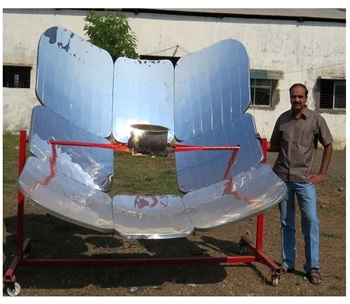
A solar cooker awarded by the Department of Science and Technology may be an answer for rapid cooking needed in community kitchens. It concentrates sunlight and speeds up cooking as a smart solution. The technology has received the National Grand Challenge Award announced by the Department of Science and Technology (DST) to commemorate the 150th birth anniversary of Mahatma Gandhi.
DST had announced a call inviting applications for the awards to promote the ideals of Mahatma Gandhi of self sustainable rural villages utilizing clean energy resources.
Dr. Ajay Chandak,, ‘Suman Foundation’, Shamgiri, Agra Road, Deopur, Dhule, won the under the category of Small Community Cooking for developing Solar concentrating community cooker with square segmented reflector dish.
This smart community (40-50 people) solar cooker with square segmented reflector dish is easy to transport, fits in 3 boxes and its’ total weight is less than 100 kgs. Equipped with a Square Segmented Reflector Dish the solar cooker has a robust design with reflectors fully supported by G.I. dish shapes.
Dr Chandak started with the conventional geometry of dish concentrators which are parabolic in shape and developed a circular dish cooker of 4 sqm aperture area. This solar cooker worked well in the field and many projects were done with this design.
Based on encouraging experience of this geometry, Dr Chandak conceived a geometry where the square dish was made in sheet metal panels and multiple panels were bolted together. Domestic design was made in 4 segments. But for small community design of 4 sqm, size of 4 segments was too big to transport. Hence the dish was made in 8 segments-- 4 corner segments and 4 middle segments.
The consistent geometry and high scalability was possible in short time because of use of moulds for forming base of the dish. The additional advantage is easy operation and practically no maintenance. The system has been installed in several tribal schools in India and has been demonstrated in few African countries also.
Solar concentrators are fast and capable of delivering cooking operations like frying. There are many designs for domestic applications and most popular design is SK-14 of Dr Dieter Seifert that can cook for 10-15 people per day with only 2-3 hours of sunlight. An innovative design known as PRINCE-15, takes care of many limitations of SK-14 and is much superior in almost all aspects namely; rigidity, cooking speed, ease of assembly and installation (DIY kit), scalability of production etc.
Evolution of an innovative design approach
The currently awarded cooker is a unique square paraboloidal dish in 4 segments. Segments are made from G.I. sheets pressed in a specially designed die to get the desired shape. Anodized, polished, hardened aluminium reflectors are screwed on this dish segments.
Realizing the limitations of the popular circular paraboloidal dish, Dr Chandak started with a similar geometry and further developed fabricated version of square dish which had all dish segments of same geometry.
Further development led to paneled solar concentrator where reflector dish shape was made in 4 pressed panels in G.I. sheets and with reflectors on top. This geometry permitted design in knock down assembly and easy transportability of the solar cooker. Height of the focus was also reduced by 20%.
The solar cooker can be packed in 3 small boxes and can be transported easily anywhere in the world. DIY (Do It Yourself) kit nature of the design permitted that the user can assemble the solar cooker on its own. It has a sturdy and compact design as far as transportation and usage is concerned.
As the complex geometry of section of paraboloid is formed using moulds and G.I. sheet pressed on hydraulic press, consistent geometry and very high scalability is attained.
Solar point concentrators can focus solar radiation from large area in very small area at the focal point. Any pot kept at the focus will get heated because of this concentrated heat. Black pots will invariably absorb more heat.
Paraboloidal reflectors are most popular concentrators used for creating a point focus. This is because paraboloids with deep focus (focus inside the paraboloidal dish) will have shorter focal length and will not require very frequent tracking.
Black pots kept at focal point will absorb concentrated heat and this will raise temperatures sufficiently for most of the cooking applications. When solar radiation is intermittent, the black pot is kept inside a glass bowl. Glass bowl works as a greenhouse and traps even diffuse radiation and does not allow heat from the pot to be lost to the atmosphere.
Very sharp focus at one point can cause food burns and very large focus area results in lower temperatures. One has to find optimum size of focus to keep balance.
Besides, to prevent reflector materials from getting oxidised and lose reflectivity, aluminium reflector surface is anodised so as to protect from oxidation and provide very high reflective life.
The solar cooker has a proven track record. It works in direct sunlight, but in case of intermittent direct sun and diffused radiation black pots are placed inside the glass bowl to get the desired performance.






























